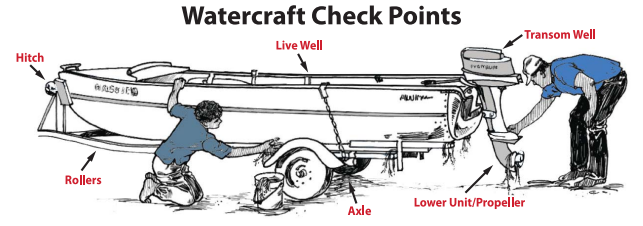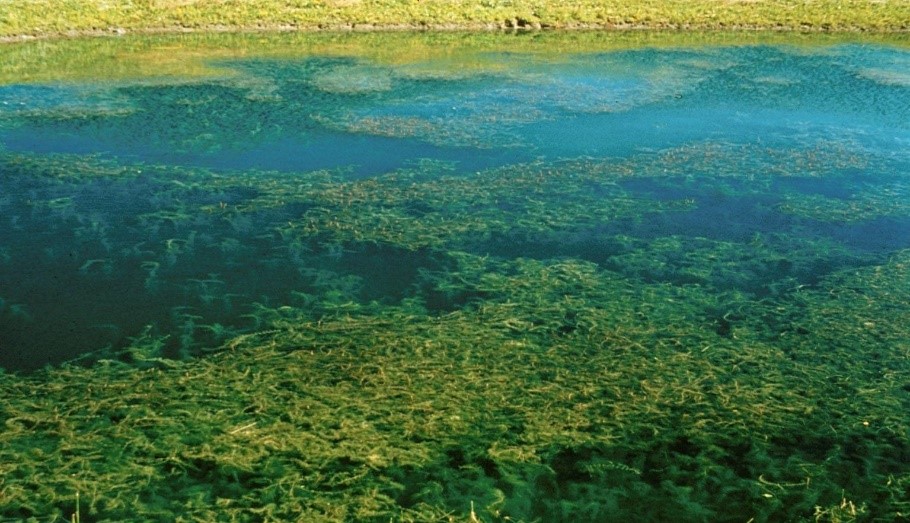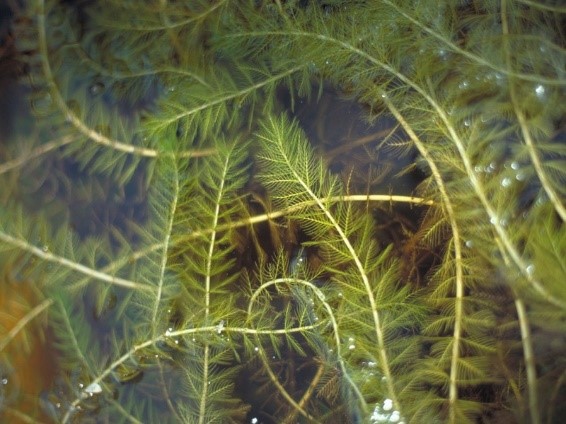Eurasian Watermilfoil
| Eurasian Watermilfoil |
 Eurasian watermilfoil is a submersed aquatic plant that has become a major aquatic invader across much of North America. Plants are rooted at the lake bottom and grow rapidly creating dense beds and canopies. Milfoil typically grows in water 3 to 13 feet deep. It is a submerged perennial that looks like many native aquatic plants, including native milfoil species. Eurasian watermilfoil usually has four feathery leaves whorled around the stem. Each leaf is finely divided, has greater than nine leaflets, and leaf tips are flat. Eurasian watermilfoil is a submersed aquatic plant that has become a major aquatic invader across much of North America. Plants are rooted at the lake bottom and grow rapidly creating dense beds and canopies. Milfoil typically grows in water 3 to 13 feet deep. It is a submerged perennial that looks like many native aquatic plants, including native milfoil species. Eurasian watermilfoil usually has four feathery leaves whorled around the stem. Each leaf is finely divided, has greater than nine leaflets, and leaf tips are flat. .jpg) .png)
Why is it bad?
Ecologic damage. Eurasian watermilfoil forms dense canopies at the water surface thereby reducing light penetration, and causing a reduction in native plants and native fish species. Milfoil-infested lakes tend to have reduced fish spawning areas and lowered fish growth rates. Native waterfowl in the Great Lakes have been found to avoid foraging for food in beds of Eurasian watermilfoil.
Economic damage. The negative impacts on wildlife and fish populations in waterbodies with high densities of Eurasian watermilfoil and the difficulty of motorboating and swimming in infested areas result in recreation-oriented financial losses and the depreciation of shoreline property values (accompanied by a loss of real estate taxes to local economies). It is estimated that milfoil control efforts have cost the United States millions of dollars per year nationwide. Annual control costs in New York state easily exceed half a million dollars per year. Saratoga Lake has become infested with a dense mat of milfoil that extends 30 to 50 feet from the shore, and one to two feet thick. Thousands of dollars are spent each year to “harvest” a portion of the growth, in an attempt to keep part of this lake’s surface clear.
What can be done to help prevent introducing this pest to lakes in our area? Aquatic Invasive Species are often transported from one lake to another by boaters who move their boats from one lake to another. Invasive species can also hitchhike on fishing equipment. The best way to help prevent introducing an aquatic invasive species is to clean and dry all equipment before putting it into a new lake or waterway. After an invasive species becomes established in a new environment, it can be very difficult to eradicate the invader. Hence, prevention is the best defense against invasive species, to keep them from being introduced to areas where they do not belong. Where this species grows in its native environment, insects and fish may feed on this plant at such a rate as to control its growth. In our area, this plant has no natural predators to keep its population in check. Under optimum temperature, light and nutrient conditions, milfoil may grow up to an inch per day. How Did Exotic Milfoil Become Established in This State? It was most likely a "stowaway" fragment attached to a boat or trailer that came to this region. Milfoil can live out of water for many hours if it remains moist. Eurasian watermilfoil has already been found in lakes in the Adirondacks, including Lake Algonquin, in nearby Wells. However, this invasive pest has not yet been found in any lakes in the Town of Lake Pleasant, and we want to keep it that way. Conventional control efforts such as mechanical harvesting have been unsuccessful in providing more than short-term relief. The use of herbicides has been found to suppress regrowth for six weeks to a year but have considerable negative effects on non-target organisms (e.g., mortality of native plants, fish kills, increased algal growth, and contamination of public water supplies). Mechanical harvesting can result in short term localized population reductions but these methods are labor intensive and costly; continued relief must be supported by long-term mechanical intervention. Further, since harvesting inevitably results in the release of milfoil fragments, the harvesting process itself may be responsible for spreading the plant to un-infested areas. You can help prevent transportation of invasive species from one lake to another by following the practice of CLEAN – DRAIN – DRY to remove plant fragments from boats and equipment. Remember that this applies to canoes and kayaks, as well as power boats and personal watercraft (PWCs, or jet skis). You can help Stop Aquatic Hitchhikers! 
Cornell University Cooperative Extension
Adirondack Park Invasive Plant Program (APIPP)
Hamilton County Soil & Water Conservation District |
|
|
| Eurasian Watermilfoil |
|
Eurasian watermilfoil is a submersed aquatic plant that has become a major aquatic invader across much of North America. Plants are rooted at the lake bottom and grow rapidly creating dense beds and canopies. Milfoil typically grows in water 3 to 13 feet deep. It is a submerged perennial that looks like many native aquatic plants, including native milfoil species. Eurasian watermilfoil usually has four feathery leaves whorled around the stem. Each leaf is finely divided, has greater than nine leaflets, and leaf tips are flat.
Why is it bad?
Ecologic damage. Eurasian watermilfoil forms dense canopies at the water surface thereby reducing light penetration, and causing a reduction in native plants and native fish species. Milfoil-infested lakes tend to have reduced fish spawning areas and lowered fish growth rates. Native waterfowl in the Great Lakes have been found to avoid foraging for food in beds of Eurasian watermilfoil.
Economic damage. The negative impacts on wildlife and fish populations in waterbodies with high densities of Eurasian watermilfoil and the difficulty of motorboating and swimming in infested areas result in recreation-oriented financial losses and the depreciation of shoreline property values (accompanied by a loss of real estate taxes to local economies). It is estimated that milfoil control efforts have cost the United States millions of dollars per year nationwide. Annual control costs in New York state easily exceed half a million dollars per year. Saratoga Lake has become infested with a dense mat of milfoil that extends 30 to 50 feet from the shore, and one to two feet thick. Thousands of dollars are spent each year to “harvest” a portion of the growth, in an attempt to keep part of this lake’s surface clear.
What can be done to help prevent introducing this pest to lakes in our area? Aquatic Invasive Species are often transported from one lake to another by boaters who move their boats from one lake to another. Invasive species can also hitchhike on fishing equipment. The best way to help prevent introducing an aquatic invasive species is to clean and dry all equipment before putting it into a new lake or waterway. After an invasive species becomes established in a new environment, it can be very difficult to eradicate the invader. Hence, prevention is the best defense against invasive species, to keep them from being introduced to areas where they do not belong. Where this species grows in its native environment, insects and fish may feed on this plant at such a rate as to control its growth. In our area, this plant has no natural predators to keep its population in check. Under optimum temperature, light and nutrient conditions, milfoil may grow up to an inch per day. How Did Exotic Milfoil Become Established in This State? It was most likely a "stowaway" fragment attached to a boat or trailer that came to this region. Milfoil can live out of water for many hours if it remains moist. Eurasian watermilfoil has already been found in lakes in the Adirondacks, including Lake Algonquin, in nearby Wells. However, this invasive pest has not yet been found in any lakes in the Town of Lake Pleasant, and we want to keep it that way. Conventional control efforts such as mechanical harvesting have been unsuccessful in providing more than short-term relief. The use of herbicides has been found to suppress regrowth for six weeks to a year but have considerable negative effects on non-target organisms (e.g., mortality of native plants, fish kills, increased algal growth, and contamination of public water supplies). Mechanical harvesting can result in short term localized population reductions but these methods are labor intensive and costly; continued relief must be supported by long-term mechanical intervention. Further, since harvesting inevitably results in the release of milfoil fragments, the harvesting process itself may be responsible for spreading the plant to un-infested areas.
You can help prevent transportation of invasive species from one lake to another by following the practice of CLEAN – DRAIN – DRY to remove plant fragments from boats and equipment. Remember that this applies to canoes and kayaks, as well as power boats and personal watercraft (PWCs, or jet skis). You can help Stop Aquatic Hitchhikers!
Cornell University Cooperative Extension |
 |




